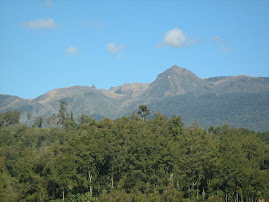This article was published by Sunday Chronicle weekly newspaper on Sunday August 30, 2009 under the the "letter from China" column.
....................
By NCEPU Beijing PNG Students
PAPUA NEW GUINEA’S first and ever new Chinese Language Star, Jack Pokoe who was awarded by China as the “Star of Chinese Characters” traveled to Huai Rou Sheng Cun Dao in China under a formal but special arrangement made by Beijing Chinese Education (BCE) authority.
This special travel included other foreign students who were also awarded Chinese Language Stars by BCE authority.
BCE authority felt very pleased to promote this travel and so proud to involve students from all around the globe to practice Chinese language and experience Chinese tradition during their travel.
Staying firm to the culture and tradition of the language, Jack has just experienced how important Chinese culture and tradition has practically helped enhance and enrich his Chinese learning abilities, skills and knowledge as a whole.
His first cultural experience involved a university travel to Shanxi Province, to an ancient Chinese city historically known as Pingyao Shi.
Shanxi Province is a distant province from Beijing, compared with Huai Rou Sheng Cun Dao, which is a cultural site within the vicinity of Beijing but at a closer proximity to Beijing City.
The travel to Shanxi was arranged by North China Electric Power University in Beijing, the Beijing campus university where Jack learns and studies in Chinese language as a Software Engineering student, currently with two (2) other PNG students, namely Joshua Oki and Joel Hip.
Joshua and Joel are students in Computer Science and Technology and Business Management respectively.
The main purpose of the travel to Huai Rou Sheng Cun Dao was to practically learn and experience the Chinese culture and tradition to appreciate its uniqueness.
The travel to Huai Rou Sheng Cun Dao was on June 06, 2009. This was after May 22, 2009, when Beijing Chinese Education Network (BCEN) specially awarded Hanzi Zhixing (the Star of Chinese Characters) to Jack.
Traveling from Beijing City is some thousand kilometers to Huai Rou Sheng Cun Dao. But access to that ancient town takes less than 4 hours by coach.
Shanxi, as compared with Hua Rou Sheng Cun Dao is almost 10 hours drive along the flat farmlands where one can find in the vast landmass of China today. The highway meanders like a stressing snake through the plains from the bird view.
The international Chinese Star foreign students who traveled to Huai Rou Sheng Dao were the Chinese power representative of twenty six (26) best foreign students of the Year 2009 International Students Chinese Speaking Competition.
These 26 best Chinese Language Stars represented their own universities. The total numbers of universities selected were less than China’s capital city, Beijing, which has a total of 32-plus universities.
The Chinese Star foreign students come from South Korea, South Africa, Vietnam, North America, Sudan, Russia, Japan, Papua New Guinea, and the others who were selected for the final and utmost Grandly-Xiu Chinese language competition, which was held at Beijing Language and Culture University in Beijing on May 22, 2009.
Jack Pokoe, the Hanzi Zhixing, was the only Chinese Star foreign student of Papua New Guinea to travel with these other international Chinese Language Stars to Hua Rou Sheng Cun Dao cultural site.
The misty cold condition of the light showering morning icily welcome the arrival of the two (2) jumbo coaches occupied by the Chinese Star international students and Chinese language lecturers at about 10 am to begin the site walk.
The site walk had begun in teams of Chinese Language Stars, after advice and information were given by the Chinese language lecturers and a Chinese culture representative at the site.
A total of four (4) teams were formed, each having a representative to monitor the group’s participation during the travel. Each team’s participation was enjoyable and exciting through the involvement in Chinese cultural activities. The cultural activities ranged from a variety of ancient Chinese history, custom and tradition.
The involvement of each foreign student in the cultural activities showed the value of Chinese tradition and the language itself.
During the site travel, Jack, the Hanzi Zhixing involved in Chinese dialogues with his team members. The other three (3) teams, including communicating in Chinese with the accompanying Chinese language lecturers from among thirteen (13) best selected universities, which included North China Electric Power University, Beijing University of Technology, Tsinghua University, China Renmin University, Beijing International Language University, and Beijing Language and Culture University.
Huo Yue Hua, was the only senior Chinese language lecturer from NCEPU in Beijing to guide and advise Jack and his South African university mate from Rwanda, named Samuel, both of whom have succeeded well into the extreme of Chinese speaking ability, and also have gained the skills to comprehend in Chinese.
The Chinese Stars were involved in Bow and Arrow Shooting, Stump and Axe Plunging, Grains Grinding, Plastacine Art Working, and most importantly included Chinese Ink Art Designing.
Through the involvement of these cultural activities, Jack has gained a rewarded experience from unforgettable China.
Chinese Ink Art Designing carried on with conversations among the traveling group. As being spoken and written of, Chinese ink has a unique history in ancient times in China.
Chinese ink and design with writing had been developing rapidly in the past until today. The history still remains.
Jack says that this travel was a wonderful China experience to use Chinese ink and learn Chinese Art Designing. This event was a special cultural activity which took place in a Chinese traditional dye house, which was built in such a way to stand out Chinese traditional styles, of which the most common style is the Chinese Dyke house.
Instructions were given by the Chinese art designers, whom were females of this skilled art. Jack followed the instructions in Chinese language and learned Chinese Art Design with the other Chinese Star international students.
Chinese language was the required language that was used to converse with each other while the student was concentrating on the art work in the art design room.
This Chinese traditional dye house displayed paintings that resemble Chinese Art history. Another similar style house displayed Chinese artifacts ranging from plastacine to ceramic artifacts that portray images of ancient China.
Chinese custom and tradition originally and naturally binds hand in hand with the Chinese language, which is nationally utilized by the Chinese people and less than estimated 100 million foreigners as a dynamic language in education, work, technology, health, transportation, communication, and in the latest rapid boosting of China’s development and economy. Therefore, the traveling group’s main communication was still conveyed in Chinese.
Even though English language is commonly known and used by these Chinese Star foreign students, it is misunderstood by majority of the native speakers, still holds sufficiency, and is being translated in communication and writing in Chinese.
The Chinese language lecturers accompanied the Chinese Star foreign students around the cultural site while speaking with them in the Chinese standard language formally known as Chinese Mandarin.
The foreign students experience that in order to stay in tune with the language. The students should be accustomed to its custom and tradition, which are highly respected by the natives and government of China.
Chinese language is not very easy to learn, study and/or study with because it is too complicated and complex. Chinese Mandarin is simplified Chinese but still too complex and difficult to easily grasp and use in writing, reading, speaking and listening.
Misunderstanding in speaking and listening can result in a common response by the native speakers using Mandarin as “Ting bu dong” or “Mei ting dong”. Because of this misunderstanding communication is not easily conveyed between foreigners and the Chinese.
Even more difficult, the language tones have distinct pronunciation, which is certainly misunderstood in oral communication unlike English’s straight sounding tones.
Furthermore, writing and reading Chinese characters is the toughest challenge but a rewarding experience being gained by the international foreign students.
Chinese language is rated as one of the most difficult languages to learn, together with Arabic, Japanese and Korean, for people whose native language is English.
But in PNG, we have more then 860 different languages where we are adopted to different cultures and languages. This places any PNG students who are interested to study Chinese language to grasp the basic elements of Chinese language easily in a short period of time.
Note: Jack Pokoe is a PNG Student at North China Electric Power University, Beijing and studies Software Engineering under the Computer Science Department. This column talks about PNG student’s life in China.
American movie include Fijians as cast and crew
7 years ago








